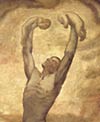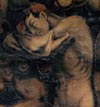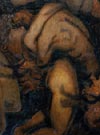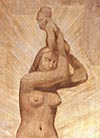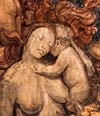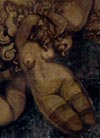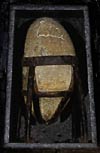
|
|||||
|
|
|||||
|
|||||
TOMBA EMMANUELLE
The original plans for Emanuel Vigeland Museum show that the large main
hall was intended as an exhibition space for paintings and sculptures.
Only the end wall and the ceiling were supposed to be covered with fresco
paintings. In the 1940's the windows were filled with brick and the building
changed character from museum to mausoleum. For the decoration of the
high-vaulted, dark room Vigeland found inspiration in the burial chambers
of Antiquity, especially the Etruscan. But the dramatic stories of Christianity
also offered rich impulses, such as the Creation and the Original
Sin as they had been narrated in Italian Renaissance frescoes. In
accordance with these southern prototypes he named his future burial place
Tomba Emmanuelle (Emanuel's Tomb). The fresco paintings that now
cover all the walls and the ceiling were named Vita (Life). The
theme of Vita is eroticism and man's sexual instinct, conveyed
through multitudes of naked bodies, women and men in impetuous intimacy.
Lovemaking and procreation in the honour of God takes place in front of
a dark and infinite universe, dimly lit by the life-giving, divine sun
but also by the blazing fires of hell. (It is the wish of the artist that
the artificial lighting in the room is kept to a minimum, so that the
drama of Vita is gradually revealed, as the eye of the spectator
grows accustomed to the darkness.)
| The end wall is dominated by man who raises his offspring towards the light and God. Before him lies the woman who has recently delivered. Infants crawl around them. Framing this central motif is a long series of other groups, couples making love, women giving birth, children playing. The formal composition of the end wall draws upon monumental frescoes of earlier times of The Final Judgement, inhabited by the blessed and the damned with the judging Jesus Christ as the central element. In Emanuel Vigeland's late-symbolist universe, Christian conceptions are blended with scientific and Darwinistic ideas. | |
| In a lyrical text about the decoration, Emanuel Vigeland writes: "Mighty is God. His is the power, and the will of men and women expires and life is created./ That which in blind sensual ecstasy is thus created, neither of them knows of it, for they are merely slaves to humanity and servants of their God." The notion of Man as the slave of procreation and the continuation of his family feeds many motifs with a sensitive, almost melancholy undertone. Sensual pleasure and frivolity is scarce in the love-making crowd. | |
| Before entering the main room the visitor will encounter an admonishing Latin text above the entrance door: Quicquid Deus creavit purum est. (Everything created by God is pure.) Vigeland feared, understandably, that the public would misunderstand the religious message of the pictures and be morally offended by the erotic scenes. "When you see a naked human body and are vexed at what you see," he has written on a drawing, "then reproach God for what he has created, if you dare." | |
| A central motif on one side wall is death, which seems to ascend from a love-making couple. He holds a newly born, screaming infant in his bony hands. Is the drama of the story that the infant dies at birth? Or should the picture be interpreted as if death is a presupposition for Life? Another infant can be seen below the lovers, lying on a bed of human skulls. "No power can halt the flow of life, for God accounts for all./ In conception God is He who gives, and in death it is He who takes back." | |
| The theme and tone of the left side wall are lighter than on the other walls. Here woman is celebrated as mother. On the centre of the wall, surrounded by a heavenly host of infants, woman appears against a brightly lit background. She holds a child above her head, others are crawling around her feet. The woman is standing on the back of some sort of primeval woman, half buried in mire. Here too a series of human skulls illustrate the past and the eternal circle of life. | |
| Vigeland trained as a painter around the turn of the century during the symbolist period in painting. Even though the fresco paintings in Tomba Emmanuelle were carried out between the world wars, some as late as the 1940's, the perception of form and the drawing of figures is still influenced by Jugend or Art Nouveau. The mask-like faces, lacking individualising traits, and the highly emphasised line rhythm, particularly in the women's hair, is also reminescent of the Art Deco of the 1920's. | |
| One of the most peculiar (and content-wise somewhat obscure) motifs is found on the short wall by the entrance. A dead couple, still embracing in copulation, produces a mighty pillar of smoke and infants. The artist's thought is probably that the act of creation, birth and deah are inseparably joined in a dramatic, eternal circle. | |
| Most of the several hundred figures in Vita are described as weightlessly floating within the universe. The story of Man is not connected to specific environments, societies or geography. We are situated in the world of ideas, in which Emanuel Vigeland's vision of a modern Genesis is coloured by both older theological conceptions as well as newer philosophical and Darwinistic thoughts. | |
| Emanuel Vigeland was the architect of his own museum, drawn by himself down to the smallest detail. Pay notice to the many wrought iron works and decorative building elements. Some of the works disclose the fact that Emanuel was under considerable influence from his brother Gustav. It was particularly in his youth that Emanuel was preoccupied by his older brother's art. They were also of the same generation and were thus in receipt of many of the same impulses and ideals. | |
| Emanuel Vigeland's urn is placed in the entrance wall. It consists of a hollowed stone, taken from the artist's summer residence at Tjøme. Vigeland writes: "When thus my hour is nigh, my body weary and my mind dull, let me then face the sun and quietly pass away./ Fire so pure, receive my body so that, fully cleansed, it can meet God./ Lay these ashes, which once was a life for better or worse, in the ovary-shaped stone, in memory of my dear mother./ And underneath, on the golden base of the urn, shine the letters God." |

